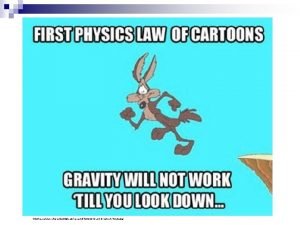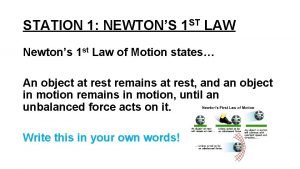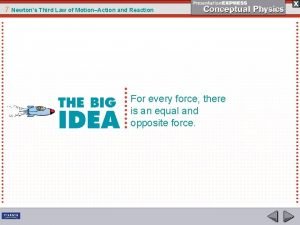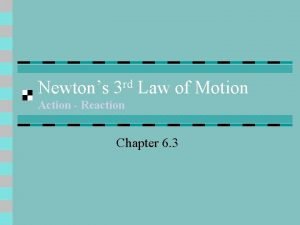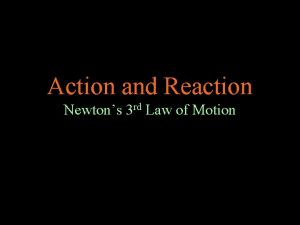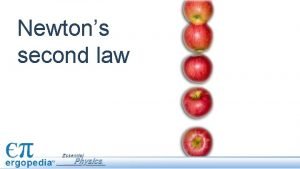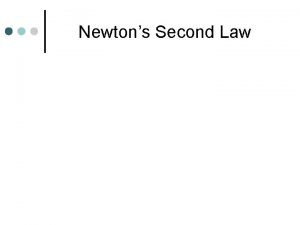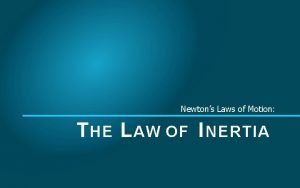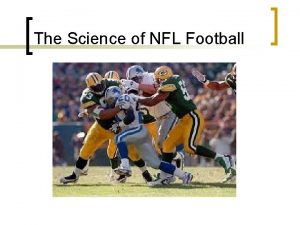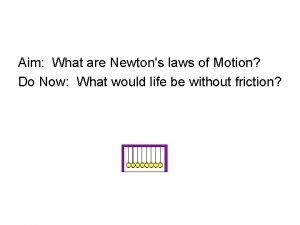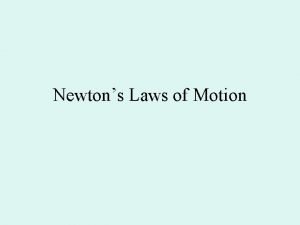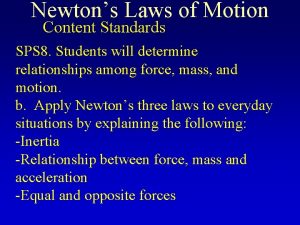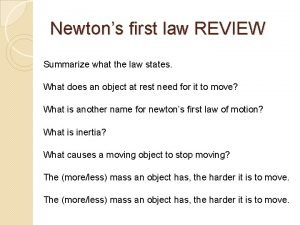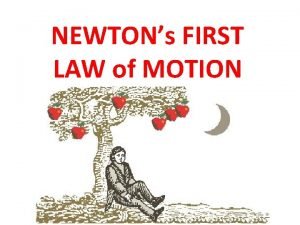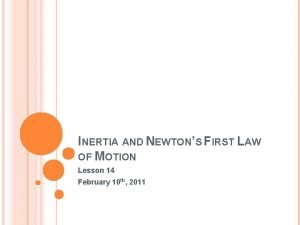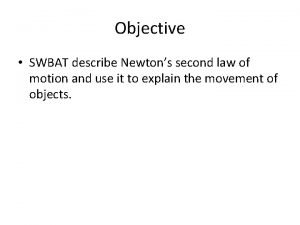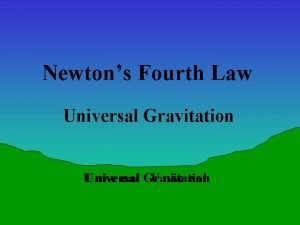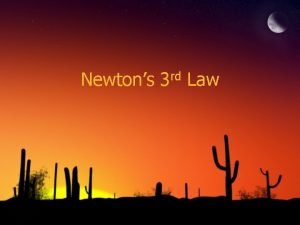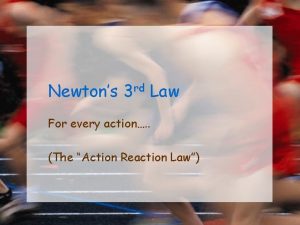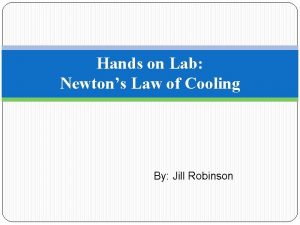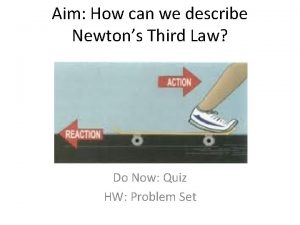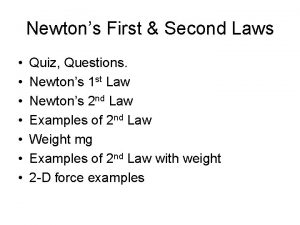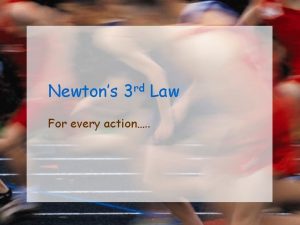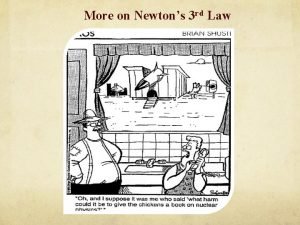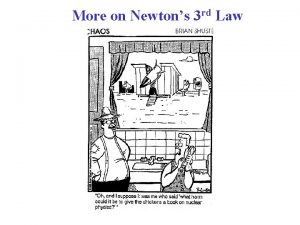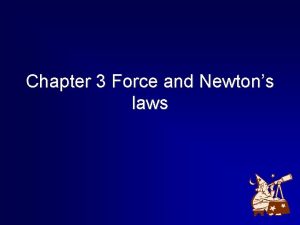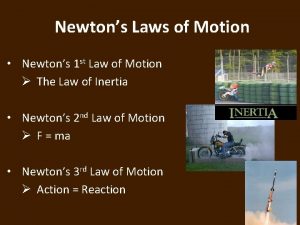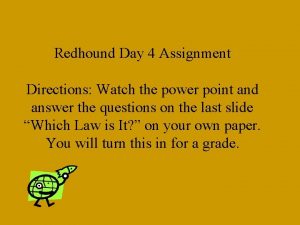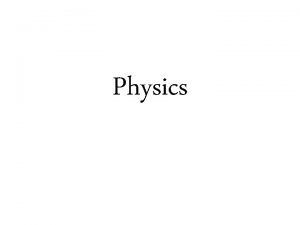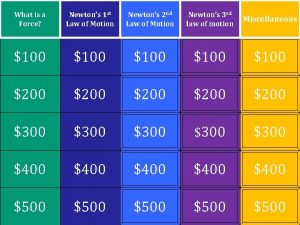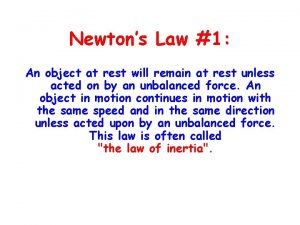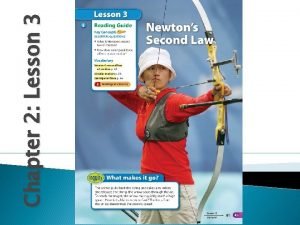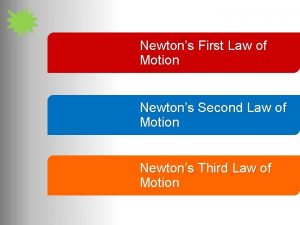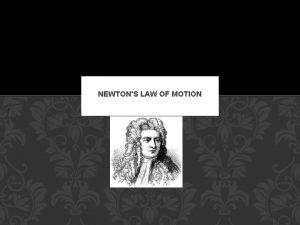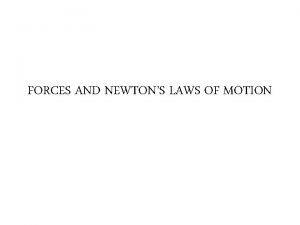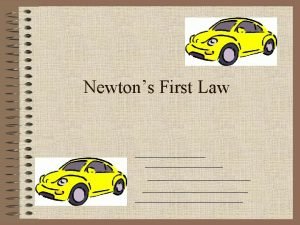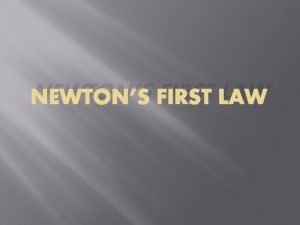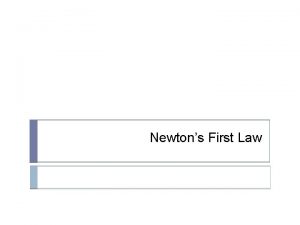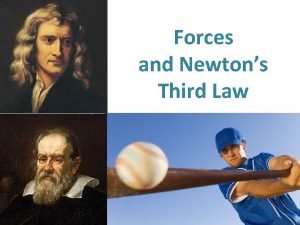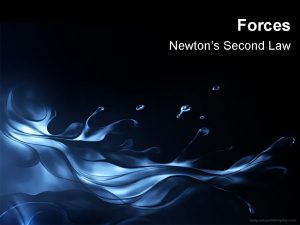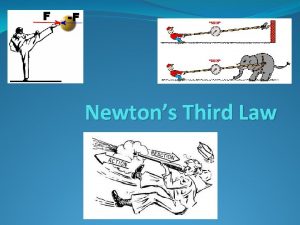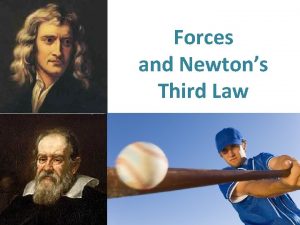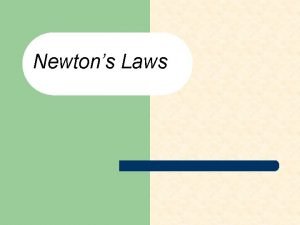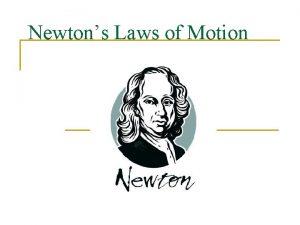Newtons First Law of Motion Forces The Law

































































- Slides: 65

Newton’s First Law of Motion Forces & The Law of Inertia

To aid your understanding: • • Aristotle's Ideas of Motion Galileo's Concept of Inertia Newton's First Law of Motion Net Force and Vectors The Equilibrium Rule Support Force Equilibrium of Moving Things The Moving Earth

Aristotle's Ideas of Motion • Natural motion – Straight up or straight down for all things on Earth – Ex: Falling Leaves – Beyond Earth, motion is circular – Ex: The Sun and Moon continually circle Earth. • Violent motion – Produced by external pushes or pulls on objects – Ex: Wind imposes motion on ships.

Galileo's Concept of Inertia Galileo demolished Aristotle's assertions in the 1500 s. Galileo's discovery: • Objects of different weight fall to the ground at the same time in the absence of air resistance. • A moving object needs no force to keep it moving in the absence of friction.

Galileo's Concept of Inertia Force • is a push or a pull. Inertia • is a property of matter to resist changes in motion. • depends on the amount of matter in an object (its mass).

Galileo's Concept of Inertia • Balls rolling on downward-sloping planes pick up speed. • Balls rolling on upward-sloping planes lose speed. • So a ball on a horizontal plane maintains its speed indefinitely. • If the ball comes to rest, it is not due to its "nature, " but due to friction.

Galileo's Concept of Inertia CHECK YOUR NEIGHBOR The use of inclined planes for Galileo's experiments helped him to A. B. C. D. eliminate the acceleration of free fall. discover the concept of energy. discover the property called inertia. discover the concept of momentum

Galileo's Concept of Inertia CHECK YOUR ANSWER The use of inclined planes for Galileo's experiments helped him to A. B. C. D. eliminate the acceleration of free fall. discover the concept of energy. discover the property called inertia. discover the concept of momentum. Comment: Note that inertia is a property of matter, not a reason for the behavior of matter.

Newton's First Law of Motion • Isaac Newton was born soon after Galileo died. • In 1665, at the age of 23, Newton stated his 3 Laws of Motion which we still study today.

Newton's First Law of Motion • Every object continues in a state of rest or of uniform speed in a straight line unless acted on by a nonzero net force. • The LAW of INERTIA

Newton’s 1 st Law – Law of Inertia

Inertia • INERTIA – a resistance to change in its state of INERTIA – motion • Inertia is a “property” of ALL matter----it is NOT a FORCE which acts on matter

Inertia • Think about what happens when you suddenly stop a car. • What does your body do?

Inertia

Inertia What would happen to a ladder placed on top of a truck if it suddenly came to a screeching halt?


Inertia • Your body continues to move in the same direction. • You are RESISTING change in your state of motion: INERTIA!

Mass – A measure of inertia • MASS – the amount of material present in an – object • The amount of INERTIA an object has is dependent on its mass---1 st Law of Motion • Greater mass; Greater the inertia

• Newton’s 1 st Law of motion is affected by 2 things: 1) Any type of force (net force, friction, weight, restoring force, etc. ) 2) Inertia---which will keep the body doing what it was already doing—resistance to change

Net Force Vector quantity • a quantity whose description requires both magnitude (how much) and direction (which way) • can be represented by arrows drawn to scale, called vectors – length of arrow represents magnitude and arrowhead shows direction – Examples: force, velocity, acceleration

Net Force Definition: The combination of all the forces that act on an object is the NET FORCE—called the resultant force of vectors.

Net Force • Net force is the combination of all forces that act on an object. – Example: Two 5 -N pulls in the same direction produce a 10 -N pull (net force of 10 N). If the pair of 5 -N pulls are in opposite directions, the net force is zero.

Net Force CHECK YOUR NEIGHBOR A cart is pulled to the right with a force of 15 N while being pulled to the left with a force of 20 N. The net force on the cart is A. 5 N to the left. B. 5 N to the right. C. 25 N to the left. D. 25 N to the right.

Net Force CHECK YOUR ANSWER A cart is pulled to the right with a force of 15 N while being pulled to the left with a force of 20 N. The net force on the cart is The two forces are in opposite A. 5 N to the left. directions, so they subtract. B. 5 N to the right. The direction is determined by the direction of the larger force. C. 25 N to the left. D. 25 N to the right.

Net Force CHECK YOUR NEIGHBOR What is the net force acting on the box? A. 15 N to the left B. 15 N to the right C. 5 N to the left D. 5 N to the right ?

Net Force CHECK YOUR ANSWER What is the net force acting on the box? A. 15 N to the left B. 15 N to the right C. 5 N to the left D. 5 N to the right

NET FORCES—TYPES OF: There are 3 types of “net forces”. 1) Force vectors moving in the same direction, the resultant is found by “adding” the force vectors. 2) Force vectors move in “opposite” direction, the resultant is found by “subtracting” the force vectors to find the resultant and the direction is the same as the larger of the 2 force vectors.

NET FORCES—TYPES OF: 3) When an object is at rest, with the net force on it being zero, we say it is in a state of EQUILIBRIUM. Equilibrium – When Net Force Equals Zero

RESULT OF NET FORCES

Vectors Vector quantity • has magnitude and direction. • is represented by an arrow. • Example: velocity, force, acceleration Scalar quantity • has magnitude ONLY. • Example: mass, volume, speed

Forces • Are vector quantities since they have both “direction” and “magnitude” • Any push or pull • 4 characteristics: 1) 2) 3) 4) Net force (forces combining) distance found in pairs work opposite to each other

Instrument and Units • The instrument used to measure force is called a spring scale. • Mass is measured with a triple beam balance &/or an electronic balance. • Volume is measured with a graduate cylinder • Time with a stop-watch

Force • Force is measured in SI units called NEWTONS 9. 8 Newtons (N) of force = 1 kg of mass acted on by gravity so, 1 kg ⋅ gravity = 9. 8 N One newton , 1 N, is the force needed to accelerate one kilogram of mass at the rate of one meter per second squared in direction of the applied force so, 1 N = 1 kg⋅m/s 2

Mass, Volume, and Weight • Volume is the measure of space an object takes up. • Weight is the measure of gravitational attraction an object has to Earth. • Mass is NOT the same as weight!!

Types of Forces • 8 different types of forces which can act on objects to produce motion

Types of forces • 8 different types of forces which can act on objects to produce motion 1. 2. 3. 4. 5. 6. 7. 8. Air Resistance Force Applied Force Spring Force Frictional Force Gravitational Force Electrical Force Normal Force Magnetic Force

Air resistance force What is air resistance? Basically, it is friction between an object and the air (gas), and also in fluids (liquids). Objects moving through air encounter forces and experience conditions similar to objects traveling through liquids. f What causes air resistance? All matter is made from atoms and/or molecules. The air is no exception. When something moves through the air, it bumps into the atoms and molecules. Pressure---is a force but, it is based on the amount of area in contact

Applied force What is applied? An applied force is a force that is applied to an object by a person or another object. If a person is pushing a desk across the room, then there is an applied force acting upon the object. The applied force is the force exerted on the desk by the person.

Spring force What is spring force? Is when an object is pushed together, then when pressures taken away it pops back to its normal self. • The restoring force which acts on any type of spring is also called the elastic force. • Direction is horizontal to “restore” the stretch of the spring • Hooke’s Law

Frictional force What is frictional force? Frictional force is present everywhere in our daily life. It is simply impossible to reduce it completely. Friction is an imposed force which will act “opposite” the motion of the object. Without friction, an object would continue moving forever on a level surface. What causes frictional force? The causes of the resistive force of friction are molecular adhesion, surface roughness, and the plowing effect. Adhesion is the molecular force resulting when two materials are brought into close contact with each other resulting in heat or deformation.

Gravitational force Newton’s fiery of gravitational forces : “Every particle of matter in the universe attracts every other particle with a force that is directly proportional to the product of the masses of the particles and inversely proportional to the square of the distance between them. ” • • • Objects rolling downhill tend to speed up (accelerate) Objects rolling uphill tend to slow down (decelerate) What about those on an even surface?

Gravity as a Force Causes Motion • Objects on a level surface do not have “horizontal” acceleration but may have “vertical” acceleration depending on whether dropped or acted upon by a forcewhich is “gravity” • Horizontal motion is considered to be “constant” when forces do not act on the object

Weight • Weight is the pull of gravity on an object • Direction is always “downward”---positive value • Attraction between 2 objects with earth as 1 of the objects.

Electrical force What is electrical force? The attractive or repulsive interaction between any two charged objects is an electric force. Like any force, its affect upon objects.

Normal force What is normal force? The normal force is the support force exerted upon an object that is in contact with another stable object. For example, if a book is resting upon a surface, then the surface is exerting an upward force upon the book in order to support the weight of the book. On occasions, a normal force is exerted horizontally between two objects that are in contact with each other. For instance, if a person leans against a wall, the wall pushes horizontally on the person.

Support Force • Support force (normal force) is an upward force on an object that is opposite to the force of gravity. • Example: A book on a table compresses atoms in the table, and the compressed atoms produce the support force.

Understanding Support Force • When you push down on a spring, the spring pushes back up on you. • Similarly, when a book pushes down on a table, the table pushes back up on the book.

Support Force CHECK YOUR NEIGHBOR When you stand on two bathroom scales with one foot on each scale and with your weight evenly distributed, each scale will read A. B. C. D. your weight. half your weight. zero. more than your weight.

Support Force CHECK YOUR ANSWER When you stand on two bathroom scales with one foot on each scale and with your weight evenly distributed, each scale will read A. B. C. D. your weight. half your weight. zero. more than your weight. Explanation: • You are at rest, so F = 0. • Forces from both scales add to cancel your weight. • Force from each scale is one-half your weight.

Magnetic force What is magnetic force? Magnetic force is the same as gravitational and electrical forces in that no one knows truly what it is. Magnetic force is different from gravitational and electrical forces in that its potential and momentic energy is at the expense of an electrical field in time.

Other Forces Found On Matter Other types of forces which can also be considered equilibrant forces are: • Thrust - up ward force against gravity and air resistance • Tension/Taut - horizontal force with acts against air resistance to pull something tight • Both have a net force of “ 0”

The Equilibrium Rule: Example A string holding up a bag of flour • Two forces act on the bag of flour: – Tension force in string acts upward. – Force due to gravity acts downward. • Both are equal in magnitude and opposite in direction. – When added, they cancel to zero. – So, the bag of flour remains at rest.

The Equilibrium Rule • The vector sum of forces acting on a nonaccelerating object equals zero. • In equation form: F = 0. The red arrows represent force vectors. The sum of the two upward force vectors minus the sum of the three bottom force vectors, equals zero. We say the forces cancel to zero, and the system of Burl, Paul, and the staging is in equilibrium.

The Equilibrium Rule CHECK YOUR NEIGHBOR The equilibrium rule, F = 0 (read as ‘sum of Forces is equal to 0’, applies to A. vector quantities. B. scalar quantities. C. Both of the above. D. None of the above.

The Equilibrium Rule CHECK YOUR ANSWER The equilibrium rule, F = 0, applies to A. vector quantities. B. scalar quantities. C. Both of the above. D. None of the above. Explanation: Vector addition accounts for + and – quantities. So, two vectors in opposite directions can add to zero.

Equilibrium of Moving Things • Equilibrium: a state of no change with no net force acting – Static equilibrium – Example: hockey puck at rest on slippery ice – Dynamic equilibrium – Example: hockey puck sliding at constant speed on slippery ice

Equilibrium of Moving Things • Equilibrium test: whether something undergoes change in motion – Example: A crate at rest is in static equilibrium (no change in motion). – Example: When pushed at a steady speed, it is in dynamic equilibrium (no change in motion).

Equilibrium of Moving Things CHECK YOUR NEIGHBOR A bowling ball is in equilibrium when it A. B. C. D. is at rest. moves steadily in a straight-line path. Both of the above. None of the above.

Equilibrium of Moving Things CHECK YOUR ANSWER A bowling ball is in equilibrium when it A. B. C. D. is at rest. moves steadily in a straight-line path. Both of the above. None of the above. Explanation: Equilibrium means no change in motion, so there are two options: • If at rest, it continues at rest. • If in motion, it continues at a steady rate in a straight line.

Equilibrium of Moving Things CHECK YOUR NEIGHBOR You push a crate at a steady speed in a straight line. If the friction force is 75 N, how much force must you apply? A. B. C. D. More than 75 N. Less than 75 N. Equal to 75 N. Not enough information.

Equilibrium of Moving Things CHECK YOUR ANSWER You push a crate at a steady speed in a straight line. If the friction force is 75 N, how much force must you apply? A. B. C. D. More than 75 N. Less than 75 N. Equal to 75 N. Not enough information. Explanation: The crate is in dynamic equilibrium, so, F = 0. Your applied force balances the force of friction.

The Moving Earth Copernicus proposed that Earth was moving, circulating the Sun. • This idea was refuted by people. • Example: If Earth moved, how could a bird swoop from a branch to catch a worm? • Solution: As it swoops, due to inertia, it continues to move sideways at the speed of Earth along with the tree, worm, etc.

The Moving Earth CHECK YOUR NEIGHBOR You are riding in a vehicle at a steady speed and toss a coin straight upward. Where will the coin land? A. B. C. D. Behind you. Ahead of you. In your hand. There is not enough information.

The Moving Earth CHECK YOUR ANSWER You are riding in a vehicle at a steady speed and toss a coin straight upward. Where will the coin land? A. B. C. D. Behind you. Ahead of you. In your hand. There is not enough information. Explanation: Due to the coin's inertia, it continues sideways with the same speed as the vehicle in its up-and-down motion, which is why it lands in your hand.

Vocabulary • • • Equilibrium Force Friction Inertia Law of Inertia Weight • • • Newton’s 1 st Law New Force Kilogram Mass Normal/Support Force • Newton
 Newton's first law of motion meme
Newton's first law of motion meme Station +1
Station +1 Newtons 3 rd law of motion
Newtons 3 rd law of motion Newtons 3 rd law of motion
Newtons 3 rd law of motion Newton’s 3rd law
Newton’s 3rd law Newtons 3 rd law of motion
Newtons 3 rd law of motion Newton's third law
Newton's third law Newtons third law of motion
Newtons third law of motion Newtons 3 rd law of motion
Newtons 3 rd law of motion What are newton's 3 laws
What are newton's 3 laws Newtons 3 rd law of motion
Newtons 3 rd law of motion Application of newton's laws
Application of newton's laws Newton's 2nd law meaning
Newton's 2nd law meaning Newtons law of motion
Newtons law of motion Law of inertia example
Law of inertia example Facts about newtons first law
Facts about newtons first law Newtons first law pictures
Newtons first law pictures Colin skateboards down the sidewalk
Colin skateboards down the sidewalk What are newton's 3 laws
What are newton's 3 laws Newton's 3 laws
Newton's 3 laws Newton law three
Newton law three Newton's first law and second law and third law
Newton's first law and second law and third law Newton's first law
Newton's first law Newtons first aw
Newtons first aw Newton's first law of motion - science of nfl football
Newton's first law of motion - science of nfl football Unbalanced forces
Unbalanced forces Bottle rocket fin designs
Bottle rocket fin designs Scientific revolution inventions
Scientific revolution inventions Newton's first law of motion
Newton's first law of motion Newton's first law in soccer
Newton's first law in soccer First law of motion facts
First law of motion facts Newton's first law examples
Newton's first law examples Third law of motion examples
Third law of motion examples Summarization of newton's first law
Summarization of newton's first law Newton's first law of motion statement
Newton's first law of motion statement Newton's first law of motion
Newton's first law of motion Newton's first law of motion examples
Newton's first law of motion examples Describe newtons second law
Describe newtons second law Newton's fourth law
Newton's fourth law Newtons 3 rd law
Newtons 3 rd law Newtons 3 rd law
Newtons 3 rd law Newton’s cooling law
Newton’s cooling law Describe newtons third law
Describe newtons third law Law of thermodynamics in chemistry
Law of thermodynamics in chemistry Difference between weight and mass
Difference between weight and mass Newtons 3 laws quiz
Newtons 3 laws quiz Newtons 3 rd law
Newtons 3 rd law Action reaction forces
Action reaction forces Newtons 3 rd law
Newtons 3 rd law Is normal force always equal to weight
Is normal force always equal to weight Section 3 using newton's laws
Section 3 using newton's laws Newton's second law
Newton's second law Newtons 1 st law
Newtons 1 st law Newtons 3 laws
Newtons 3 laws What are the 3 laws of newton
What are the 3 laws of newton Newton's laws
Newton's laws Newtons second law
Newtons second law Newtons 1 st law
Newtons 1 st law Newtons second law example
Newtons second law example Newtons nd law
Newtons nd law Like parallel force example
Like parallel force example The forces shown above are
The forces shown above are Intermolecular vs intramolecular
Intermolecular vs intramolecular Difference between intramolecular and intermolecular
Difference between intramolecular and intermolecular Inter vs intramolecular forces
Inter vs intramolecular forces Force and motion
Force and motion
